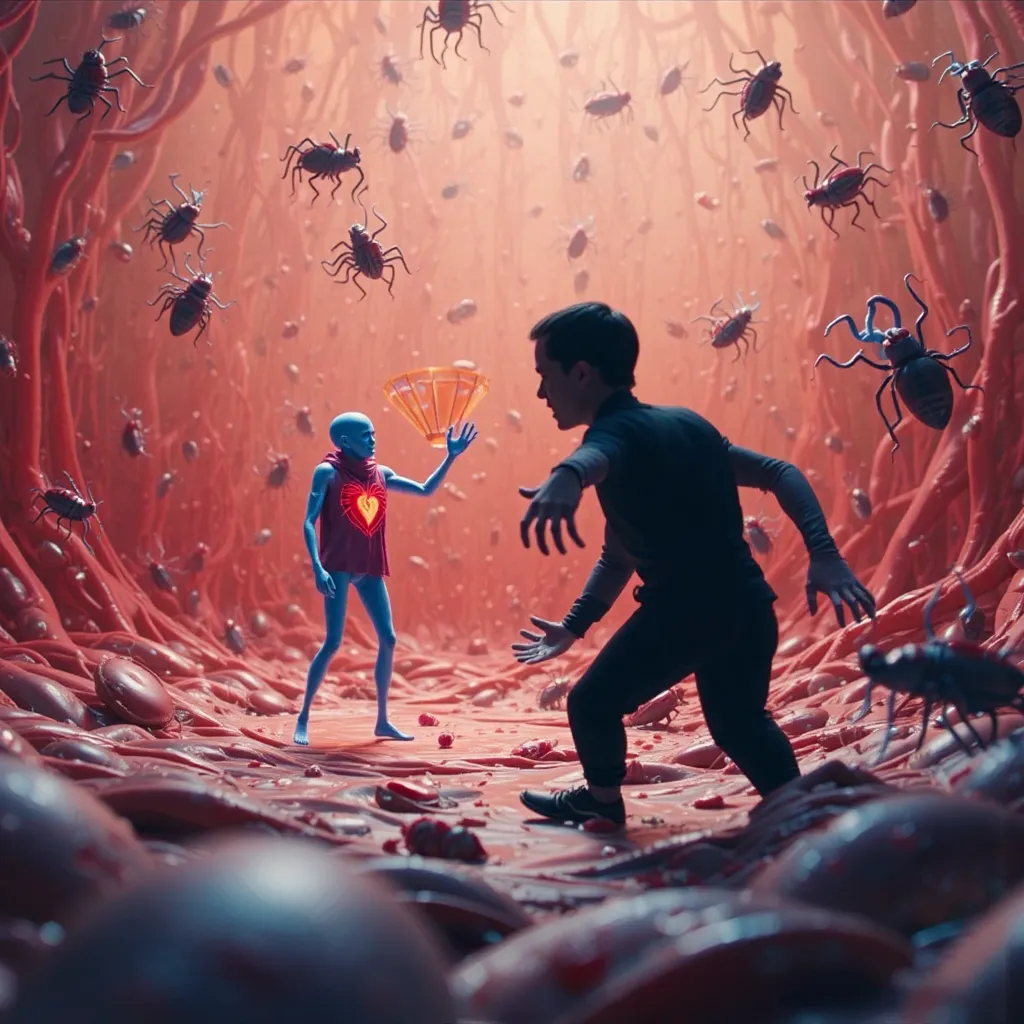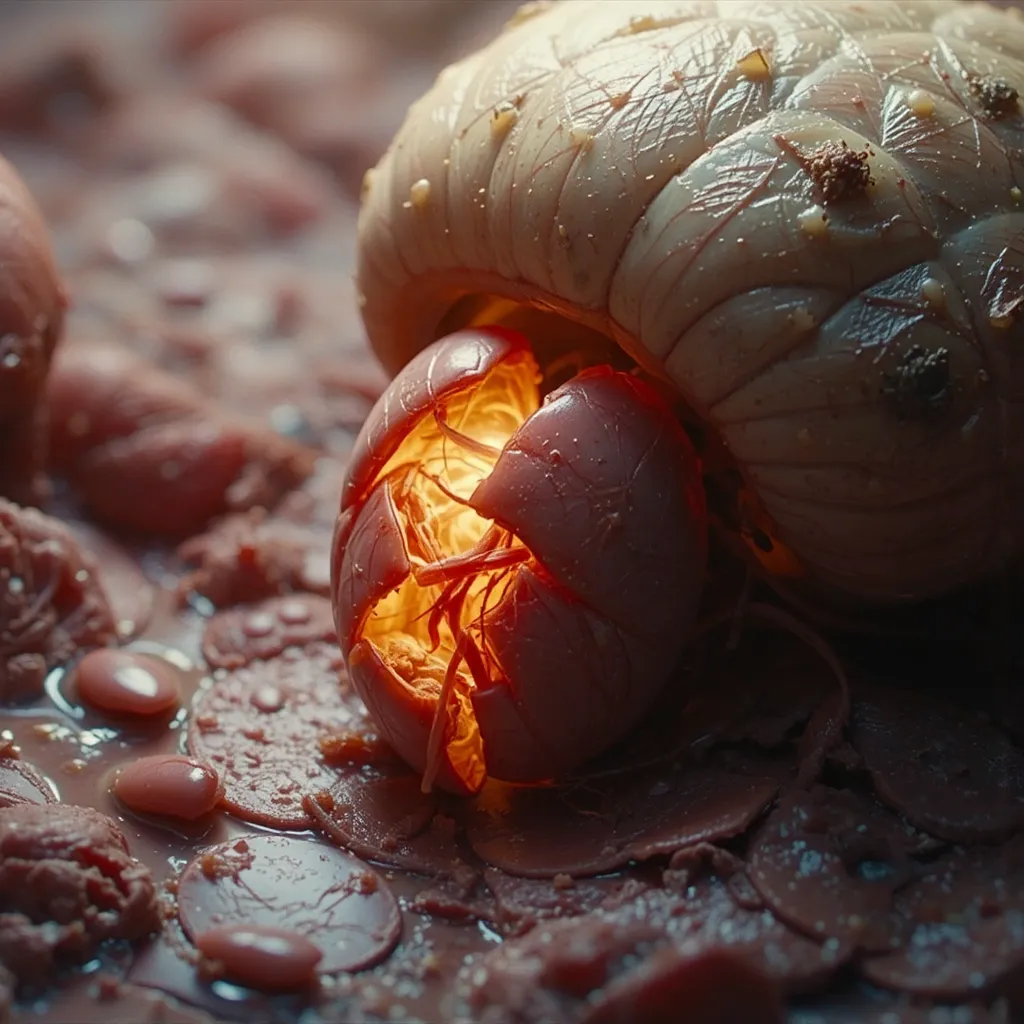osmosis jones fighting parasites
Background Description of the Setting
In the vibrant and bustling world of the human body, we find ourselves in the intricately woven tapestry of cells and biological systems. This setting mirrors a highly organized city, where life happens on a microscopic scale. The year is set in the modern age, a time when hygiene and health are paramount. The human body, particularly the bloodstream, is a labyrinth filled with nutrients and cells, reminiscent of a modern metropolis filled with bustling streets and flying vehicles. The heart is the central hub of activity, pumping the lifeblood of the body, while white blood cells, like Osmosis Jones, patrol the environment, safeguarding against intruding pathogens and parasites.
Historically, the quest to understand the body and its functions in fighting diseases emerged from the works of notable scientists, such as Louis Pasteur and Robert Koch, paving the way for modern immunology and virology. However, now, the body faces an imminent threat of malign and menacing parasites that aim to disrupt this harmonious ecosystem. These invaders, depicted as cartoonish yet sinister figures, represent a range of viruses and bacteria particularly virulent in the contemporary age, with the tension heightened due to rising health concerns globally.
The fate of this internal city hangs in the balance as Osmosis Jones grapples not just with these microscopic foes but also faces the challenge of rallying an average human body’s defenses, symbolizing the broader struggle against health issues that plague society today.
Images Generation


Character Choices
Summary
In a vibrant and bustling metropolis within the human body, Osmosis Jones faces an imminent threat from bizarre and menacing parasites. This colorful world, influenced by scientific history, sets the stage for dramatic and exciting conflict as Jones fights to protect the cellular city.
why do you think parasites look this way inside a body
Battle in the Bloodstream
Osmosis Jones soared into the bustling port of the bloodstream, racing towards an urgent alert: parasites were launching a surprise attack on the vital organs! Armed with his trusty immune toolkit, he strategized with a wary band of T-cells. The air was thick with tension as bizarre, spiky parasites swarmed, intent on hosting chaos. The looming confrontation demanded swift choices that could turn the tide. Would you encourage a risky all-out assault or devise a cunning distraction?
Make the parasites elongated with visible segments and a distinctive head section
Add a slow undulating movement pattern typical of tapeworms behavior
Osmosis Jones surged through the bloodstream, his vibrant blue hue contrasting sharply against the ominous darkness of parasitic invaders infesting vital organs. With their elongated bodies, segmented forms, and heads reminiscent of oversized tapeworms undulating menacingly, they prepared for their catastrophic feast. Each pulse of the heart sent a wave through the plasma as Jones steeled himself for battle. A sudden realization hit—an urgent decision loomed. He could either rally his immune allies or launch a surprise attack on a weakened segment of the parasite’s army.
worms connect too other worms they really dont grow
The Buildup of An Immune Response
Osmosis Jones dives deeper into the turbulent currents of the bloodstream, spotting elongated, segmented parasites known as Septic Worms wreaking havoc on vital organs. Their insidious tendrils intertwine, threatening to coalesce into a powerful mass. Unsure of what to do next, he realizes that every action counts in this critical moment. The clock is ticking, and he’s faced with a pivotal choice that could alter the course of the battle.
What should Osmosis do?

in order for worms too take you down they must mimic or clone effect of the body of you the human or robot or machine or ai
Inside the Heart’s Core
Osmosis Jones races through the bloodstream, sensing a grave disturbance. Segmented parasites, elongated and sinister, assault the heart’s vital chambers—each pulse a reminder that time is running out. As Jones gears up for confrontation, he discovers the parasites are cloning the cells they attack, aiming to weaken the body’s defenses. He must act decisively to thwart their invasion before they corrupt the entire system.
What should he do next?

So upon all this stuff and as we look into this situation.
A Critical Junction in the Bloodstream
As Osmosis Jones navigates the turbulent currents of the bloodstream, he finds himself in a dire situation. The segmented parasites swarm towards the heart, their elongated forms glistening ominously in the red light. With vital organs at stake, Osmosis senses the urgency of a decision that could alter the course of this battle. He can either launch a direct assault, rally nearby immune cells for support, or cleverly distract the parasites to buy time. The stakes are high, and the parasites evolve rapidly.

We all. Well, how I’m gonna do that when, yeah, they supposed to do it for me and I can’t. I mean, shoot.
Vital Confrontation
The bloodstream pulses with life as Osmosis Jones faces the elongated, segmented parasites swarming dangerously close to the heart. Their glistening exteriors reflect the bodily mayhem they intend to wreak. With vital organs at stake, Jones feels the weight of urgency. The parasites hiss menacingly, their movements calculated and aggressive. A pivotal choice lies ahead: attack head-on, seek reinforcements, or devise a decoy strategy to distract them. The fate of the heart—and the body—hangs in the balance as he prepares for action.
You know. Understanding and learning we’re supposed to be.
A Heart at Risk
As Osmosis Jones steels himself, the segmented parasites unleash a wave of toxins, targeting the heart. The stench of decay mixes with his sense of urgency, forcing him to act. He assesses the battlefield: the heart’s rhythm pumps steadily, but time is running out. With three options ahead, he must decide swiftly. Will he charge directly into battle, risk calling for backup, or create a crafty decoy from nearby blood cells? Each choice could determine the heart’s fate, with creeping dread motivating his decision.
With the fibrillators right, there are a lot of people with defibrillators. How does their osmosis Jones go?
A Pulse of Action
Osmosis Jones tightens his grip on the adrenaline coursing through him as he witnesses the segmented parasites multiplying, a direct threat to the heart’s functionality. The rhythm of the heart echoes like a drum, pushing him to act. Remembering the tales of past encounters, he considers his options carefully. Charging into battle may provoke an onslaught from the parasites which have been known to counterattack fiercely. He could call for backup from fellow immune responders, but delays risk further damage. Or, employing cunning, he might create a decoy to distract them.
What will Jones do to save the heart?
Fire, right? They’re gonna use half the oxygen to the fire. If they lose alone, if you lose a sign, if you lose your sign, your sinuses.
The Heart’s Last Stand
Osmosis Jones takes a deep breath, eyes focused on the writhing segmented parasites. They twirl menacingly around the heart, eager to feast on any weakness. He knows he must make a decisive choice. Direct combat could energize the parasites into a frenzy, putting him at risk. Calling for backup could take precious seconds, while a decoy might allow a stealthy attack. He feels the pressure mount as the heart’s rhythm quickens. Will he be the hero it needs?
Choose wisely:
osmosis jones and crew of jones fighting parasites
The Confrontation Begins
As Osmosis Jones sizes up the segmented parasites coiling around the heart, he can feel the urgency stirring within him. His crew of immune cells watches anxiously, ready to spring into action at a moment’s notice. He knows each second wasted could mean catastrophe for the vital organs they protect. “What’s it going to be, team?” he shouts, fear and determination mingling in his voice. With blood flowing all around like a rushing river, every choice will steer this battle’s outcome.
Do they engage now, hoping to surprise the enemy? Would it be better to summon reinforcements first, or can they outsmart the parasites with a clever distraction? What will Osmosis decide?

Call for backup from fellow immune cells.
. Rather than engage alone, he summons fellow immune cells for support. A thrilling moment ensues as a squad of white blood cells, equipped with shields and ready for battle, arrives at the scene. They form a defensive line, pushing back against the relentless parasite assault. Suddenly, a wave of backlash occurs, forcing Osmosis and his team to dodge an unexpected toxic release from the parasites! Their timely arrival changes the odds in their favor.

Engage the parasitic threat in a united front with the backup.
The Battle for the Heart
With the call for backup reverberating through the bloodstream, Osmosis Jones and a cadre of immune cells linked together, ready for a united front against the looming threat of segmented parasites. They charged forward, harnessing their combined strength, but unexpectedly faced a toxic backlash that weakened their resolve. As they fought bravely, Osmosis noticed the parasites adapting. It was now or never to outsmart them while keeping the heart intact from harm.
What crucial tactic will Osmosis employ next?

Aim for a strategic retreat to reassess the situation.
Strategic Retreat: A Critical Decision
Osmosis Jones and his allies drive forward, but the toxic backlash enhances the parasites’ strength, pushing them back. In this tense moment, Osmosis realizes a strategic retreat may give them the time needed to reassess their tactics. The decision weighs heavily as a swarm of segmented parasites clouds the path to their safe haven. What to do next is crucial for the survival of the heart and all the immune defenders.
How will Osmosis proceed from here?
group scentist jones studying the problem and how not to hurt the human body
A Tactical Retreat Amid Chaos
As Osmosis Jones huddles with his fellow immune defenders, they debate the next move to stabilize the situation. The segmented parasites loom, eager to capitalize on their moment of weakness. Osmosis proposes retreating to a safe area within the bloodstream to regroup and strategize. The team discusses the potential harm of their actions to the human body, weighing risks against the need for containment. The atmosphere crackles with tension as scientific ends justify the means, and the fate of the heart hangs in the balance.
Osmosis gathers his team, and they confront a life-or-death decision. Should they attempt to retreat, distracting the parasites, or prepare for an all-out counterattack?
use reflexology chart of body to decode the bible and mak the rest of the osmosis joneses fighting parasites
The Battle for the Heart’s Sanctity
Osmosis Jones and his team are in the thick of the battle. Faced with sheer terror, they decide to retreat strategically to a less targeted area of the bloodstream. However, as they falter, a hostile wave of parasites senses their vulnerability and begins advancing. With time running out, Jones spots a reflexology chart nearby—a surprising ally. Using it, he can decode the best path to counteract the parasites’ forces. The team must act quickly!
Which option will Jones pursue to navigate this crisis?

Decode the reflexology chart for tactics against the parasites.
Inside the Bloodstream: A Fork in the Vein
As Osmosis Jones regrouped with his fellow immune cells, the risk of overwhelming segmented parasites loomed large. Alone in a sea of chaotic blood plasma, he recalled the reflexology chart he had stumbled upon earlier, its intricate lines possibly holding the key to a strategy. With tension mounting, he realized that decoding this chart could reveal crucial tactics against the parasites, guiding their next move. But time was tight, and the pulsating heartbeat of the heart increased the urgency.
In the midst of chaotic swirls, he had to choose quickly how to interpret this information.

Create a decoy to draw the parasites away.
The Decoy Strategy
Osmosis Jones quickly realized that confronting the segmented parasites alone could lead to disaster. Instead, he conjured up a brilliant plan to create a decoy to draw their attention away from the heart. He fashioned a replica of himself from plasma, a shimmering illusion designed to mimic his movements and emit signals that would attract the parasites. As the decoy darted through the bloodstream, the parasites eagerly pursued it, leaving the heart momentarily vulnerable. However, unexpected complications arose as the parasites began to adapt to his trickery.
The parasites, now furious, swarmed towards Jones, ready to retaliate. Would his decoy hold, or would he be overwhelmed?

Attempt a stealth maneuver to slide by the parasites and reach the heart directly.
Stealthy Intrusion
With the segmented parasites momentarily distracted by the decoy, Osmosis Jones seizes the opportunity to implement a stealth maneuver. He glides through the swirling, vibrant plasma, weaving expertly to avoid detection. Suddenly, he stumbles as a parasite regains focus, inching closer. A critical moment approaches—will Osmosis risk it all to reach the heart, or will caution prevail?
As he navigates deeper, a ripple of toxicity bursts through the bloodstream, intensifying the stakes. What will he do next?

the joneses decide to get person or human that is the body to help them
The Heart’s Desperate Call
As Osmosis Jones navigates through the turbulent bloodstream, the segmented parasites are enraged by the decoy’s distraction. Realizing the persistent danger to the heart’s function, Jones and his allies quickly devise a bold plan: they must get the human host involved. Perhaps a cough or sneeze could send a wave of mucus to disperse the parasites? But this risky strategy could backfire. Tension fills the air as they prepare for the next move, each pulse of the heart a reminder of the stakes.
What will Osmosis Jones choose to do?

attempt to signal the human to get him or she to do a manual override which is it putting in the chemicals needed to defeat the parasites and exercise them out would strengthen the muscles making them and he or she the body stronger and squashing the parasites
Critical Showdown
As Osmosis Jones cleverly maneuvers through the bloodstream, he realizes that the only way to fend off the relentless segmented parasites might be to signal the human host. With parasites closing in on the heart, he must act quickly. Pulsing emotions and adrenaline rush through the vibrant landscape of the bloodstream while he sends a desperate signal. Suddenly, the human body feels a long-abandoned energy surge, ready for a bold move. However, will the human be able to perform a manual override to unleash the necessary chemicals?
Choose Osmosis’s next course of action:

Attempt to signal the human to perform a manual override for defense chemicals.
Osmosis’s Last Resort
In the heat of battle, Osmosis Jones realized he had no time to waste. The segmented parasites were closing in on the heart, their elongated forms weaving through the bloodstream like snakes. Taking a deep breath, Jones signaled to the human host, urging them for a manual override to unleash a barrage of defense chemicals. As the heart pulsed with urgency, a wave of pure adrenaline surged through the vicinity. Suddenly, the human felt a surge of dizziness—an ill side effect of the parasites’ assault.
But would the signal reach the host in time?

Attempt to further amplify the signal to the human for a stronger reaction.
The Ultimate Signal
Osmosis Jones boosts his signaling power, becoming a radiant beacon in the bloodstream. He envisions a surge in the human’s defenses against the segmented parasites. The dangerous gambit could either rally the host’s immune response to a fever pitch or risk an unintended toxic backlash that could further endanger the heart. As Jones channels energy, he senses the looming threat intensifying, relentlessly circling, while the human’s biological machinery stirs in response. The potential for salvation or catastrophe hangs in the air.

Adjust the signal to also alert surrounding immune cells for backup.
The Tipping Point
In a race against time, Osmosis Jones adjusted his signal, amplifying it not only to the human host but also towards nearby immune cells. The bloodstream thrummed with energy as more allies became aware of the looming threat of segmented parasites. However, the parasites, sensing the shift, retaliated fiercely, launching toxic bubbles in a desperate bid to thwart the defense effort. Jones braced himself for the influx of immune cells, hoping this gambit would shift the tide of battle in their favor.
Will the reinforcements arrive in time to help?

has the human inputed the chemicals and started exercising or does it conitune to eat meats and do things against the real creator of all things that makes them stronger
Critical Decision in the Body
Osmosis Jones stands at a pivotal moment as he desperately signals the human host for assistance. The parasites are closing in on the heart, their elongated bodies writhing menacingly. Suddenly, the human begins to stir, but their actions are uncertain—will they choose to unleash powerful chemical defenses or continue their unhealthy lifestyle? This choice carries significant weight for the battle’s outcome. The fate of the heart—and ultimately the body—hangs in the balance.
What should Osmosis Jones urge the human to do?

Remind the human of the dangers of their unhealthy habits, trying to steer them away from harmful choices.
Pulsing Urgency
Osmosis Jones frantically signals the human host, recognizing that unhealthy habits may exacerbate the threat of segmented parasites. As he processes the urgent need for intervention, the human hesitates, unaware of their crucial role in this cellular battle. Osmosis desperately projects thoughts of dodging fast food, neglecting hydration, and the importance of a healthy lifestyle. Suddenly, a toxic bubble bursts near them, drawing the parasites’ attention. Will the human heed this warning or remain oblivious to the havoc within?
As Osmosis waits, he must now choose how to engage the human further.

how does this human learn and believe would be the answer dreams are made of display vivid imagery of healthy lifestyle to influence the human’s decisions faith is what the bible says about things of this nature revelations says one foot on land and water then the human gave the body the book of life hydrogen peroxide and on the tongue it was bitter but in the stomach it was sweet
A Race Against Time
Osmosis Jones, feeling the pressure of time, frantically signals the human, hoping the connection would lead to an effective chemical response against the segmented parasites. As the human contemplates the warring ideas of health and vitality, a moment of clarity sparks. The heart begins to falter, the segmented parasites closing in, while toxic bubbles surge dangerously close. The tension is palpable. Will the human comprehend the urgency behind Osmosis’ signals, or risk drowning in indecision?

force parasite too show itself on the outer surface of the human so it knows
The Call to Action
Osmosis Jones, overwhelmed yet determined, signals the human host with urgency. The segmented parasites, sensing the threat, release toxic bubbles, surging menacingly. With a strategic mind, Jones considers how to make the parasites reveal their weak points. Should he compel the host’s body to provoke an immune reaction or perhaps utilize environmental distractions to force the parasites to the surface? This bold move could expose their vulnerabilities but carries risks in the chaos of battle. The fate of the heart hangs in the balance.

Trigger an immune response using the human’s body to draw out the parasites.
Tension in the Bloodstream
Osmosis Jones watches the segmented parasites approach, pulses of danger thrumming through the bloodstream. Desperate, he senses the potential within the human host to unleash an immune response. With a swift motion, he signals the human, urging them to activate a wave of antibodies, drawing the parasites towards a focused strike. The atmosphere thickens as toxic bubbles float precariously. However, the moment feels precarious — a single wrong signal could lead to chaos. The human’s decision now looms large.
What will Osmosis choose next?

anti means against that would be a trick so remind the human of things it could read or digest to help or the human will die
Rallying against the looming threat of segmented parasites, Osmosis Jones realizes it’s imperative to maximize communication with the human host. He issues a critical reminder about the importance of mental focus and the host’s dietary habits, hoping to trigger a response that will unleash powerful defenses. Pumping with urgency, Jones can feel the toxic bubbles nearing, spurring him on. He remembers key nutrients that can aid in the fight; now he must emphasize a plan to engage the human.
What will Jones prioritize in his message to the human?

Advise the human to visualize fighting the parasites to boost morale.
The Human’s Resolve
Osmosis Jones watched as the human hesitated, overwhelmed by the chaotic pulse of the bloodstream and the lurking segmented parasites. Determined to rally their spirits, he urged the human to envision battling these invaders, harnessing their innate power. The heart thudded anxiously beneath the looming threat, creating a perfect storm of urgency. As visions of triumph sparked hope, a surge of energy fizzled through the bloodstream. Suddenly, the segmented parasites recoiled slightly but quickly adapted, relentless in their pursuit. Now, Osmosis had to decide his next move.

Signal for a more powerful chemical defense from the human.
The Battle for the Heart
With the heart under siege from segmented parasites, Osmosis Jones felt the urgency escalate. Channeling his resolve, he signaled the human for a stronger chemical defense. The message flowed through the bloodstream like a current, amplifying hope. The human hesitated, contemplating the request with the chaos of toxic bubbles smashing dangerously close. A surge of energy crackled as Osmosis prepared for the impending onslaught. Suddenly, the human’s head jerked in decisive action—was it a help or another miscalculation?

The human releases a potent chemical response, enhancing Osmosis’s defenses.
The Chemical Surge
As the human focuses deeply, a wave of potent chemicals floods the bloodstream, enveloping Osmosis Jones in a protective shield. The toxic bubbles, once a daunting threat, are now met with fortified resilience. Infused with new strength, Osmosis boldly charges towards the elongated segmented parasites near the heart. But suddenly, the parasites retaliate, launching hazardous tentacles. His situation is critical. Will he maintain the offensive or prepare to evade their onslaught? The fate of the heart depends on his next move.

parasites have creator on their side because he created them to make a human understand his rules and also the human has the creator on its side but the body and everything on it is muscles so the human must crack the defensive shield of the parasites like crabs crawfish when humans eat them
A Clash of Titans: Osmosis Jones vs. The Creator’s Deceit
Osmosis Jones, empowered by the human’s surge of chemical defenses, gears up for an epic showdown against the segmented parasites. To his utter surprise, he realizes they are not just mindless invaders; they have a mysterious “Creator” guiding their actions. This revelation transforms the battle and raises the stakes. With the heart still in danger, Osmosis senses the Creator’s malevolent influence stretching across the bloodstream, rallying parasites to fight harder.
As the first wave of action hits, vibrant toxic bubbles begin to form around him, threatening to burst. Osmosis knows time is critical, and he must make a decisive move.
In this new conflict, Osmosis can seek to disrupt the connection to the Creator, to fortify the defenses by reinforcing the human’s immune response, or attempt to communicate with the human for strategic insight.
What will Osmosis strive to do next?

some parasites do not obey or at one time didnt maybe his punishment on the parasites to help but some just want to be the creator and this is why he punished or how he punished them they say the creator said to satan since all you want to do is have sex then lay on your belly and crawl the creator so he gives the upper hand to the human that truly believes in him without a doubt same with the joneses hydrogen peroxide is the living water and the creator just waiting for the without a doubt
A Battle of Survival
Osmosis Jones stands firm, surrounded by the chaotic flow of the bloodstream, now empowered by a human-controlled surge of hydrogen peroxide aimed at aiding the fight against the segmented parasites. As he prepares to engage in battle, he recalls the legends of the Creator and the consequences suffered by those parasites that rebelled. They said the Creator would punish non-compliance, and now doubters within the ranks of parasites threaten both existence and vitality. The moment is tense; a choice must be made that could alter the tide of battle.
What will you decide?

Redirect the hydrogen peroxide to create a defensive barrier around the heart.
Title: The Final Showdown
As the climax of the battle unfolded, Osmosis Jones, empowered by the human’s chemical surge, made a bold decision: to redirect the hydrogen peroxide to create a protective barrier around the heart. This strategic move enveloped the sinewy organ in a shimmering cocoon, temporarily warding off the ravenous segmented parasites.
In the final hours of this epic confrontation, the atmosphere within the bloodstream was electric. Jones and his allies rallied together, forming a united front against the encroaching threat. With red blood cells and immune warriors beside him, Jones faced the segmented parasites, now enraged by their thwarted assault. The heart pulsed defiantly beneath the protective barrier, its rhythm a reminder of what they were fighting to preserve.
However, despite the brilliant display of unity and strength, the parasites struck back fiercely, launching toxic bubbles into the fray. Some immune heroes faltered, succumbing to the overwhelming aggression of their segmented foes. In this moment of chaos, a rift began to form among Jones’s allies, some seeking to retreat, while others clung to hopes of victory.
Osmosis fought valiantly, harnessing the protective powers of the hydrogen peroxide. Yet, it soon became clear that the strain of the battle was taking its toll. The barrier flickered as the toxic backlash intensified, threatening to break under the weight of the parasites’ relentless onslaught.
As the struggle reached its zenith, the heart itself joined the fight by releasing adrenaline, adding fuel to the immune response. In a stunning twist, the Creator of the parasites began to falter, realizing the precarious nature of the attack as the combined forces of Osmosis and the human host pushed back. Yet, two paths diverged—Osmosis could either push for a final offensive strike or attempt to create a lasting treaty with the remaining parasites, knowing full well the risks of both choices.
Images:





Ultimately, the story concludes with a bittersweet resolution. Though Osmosis Jones and the immune allies stood firm against the initial assault, the unyielding nature of the segmented parasites proved too strong. Despite the valiant effort, the toxic bubbles overwhelmed their defenses, leaving a somber reminder of the consequences of inaction and miscalculation.
In an unhappy ending, the heart suffered damage that could take time to mend, leading to internal struggles within the body. The balance of health and illness wavered precariously, signaling that while Osmosis fought bravely, the war against parasitic threats was far from over.
if the human didnt exercise and add all the chemicals needed to defeat parasites then it wouldnt be the end of the parasites its said that a group of worms clumped together is a cyst or tumor or polyp different enviroments of the body and how they become plus they would have too boo boo or throw up or pee pee them out
Title: The Final Showdown in the Bloodstream
As the dust settles in the bloodstream, Osmosis Jones stands at a crossroads, having valiantly fought against the segmented parasites that threatened the heart. However, despite his heroic pleas to the human for chemical reinforcements, the human remained stagnant, hindered by their choices and lack of action. Unbeknownst to Osmosis, this inertia allowed a horde of segmented parasites to regroup and grow stronger, merging into a cyst-like formation that poses an even greater threat to all vital organs.
His allies were exhausted, and though they rallied valiantly, they were unable to overcome the growing menace. The atmosphere turned somber as the heart began to falter under the pressure of the encroaching parasites, their collective power becoming too great to handle. Osmosis realized he had to protect what he could, but the looming presence of a parasite tumor, or polyp, overshadowed their efforts.





Despite Osmosis’s bravery and attempts to unite his allies, the human’s negligence hindered the crucial chemical defenses they needed. As the sentinel of the human body, he had a duty to protect. However, the outcome was grim. The parasites managed to overwhelm their defenses, transforming into a critical tumor-like entity that posed a threat beyond mere defense – forcing the human to confront the reality of their inaction.
Conclusion:
In the end, while Osmosis Jones fought valiantly against the parasites, his efforts were in vain due to the human’s choice not to respond to his calls for chemical reinforcement. The once-pulsating heart was now mere moments from succumbing to the parasite menace. The cyst-like tumor became the new ruler of the bloodstream, casting a shadow over the body’s vital functions. The realization hit hard: without human action, the battle inside would forever be an uphill struggle, marking a bittersweet chapter in the story of Osmosis Jones.
Unhappy Ending: The human’s lack of effort ultimately led to the heart’s failure and the creation of an unmanageable growth, reminding us that sometimes, the smallest choices can have the most devastating effects. The inside of the body was left in a state of permanent chaos, as new parasitic growths emerged, claiming dominion over vital pathways, leaving Osmois Jones with a heavy heart over what could have been.
bleach anime osmosis jones fighting parasites a cyst a tumor a polyp is a group of worms clumped together























































